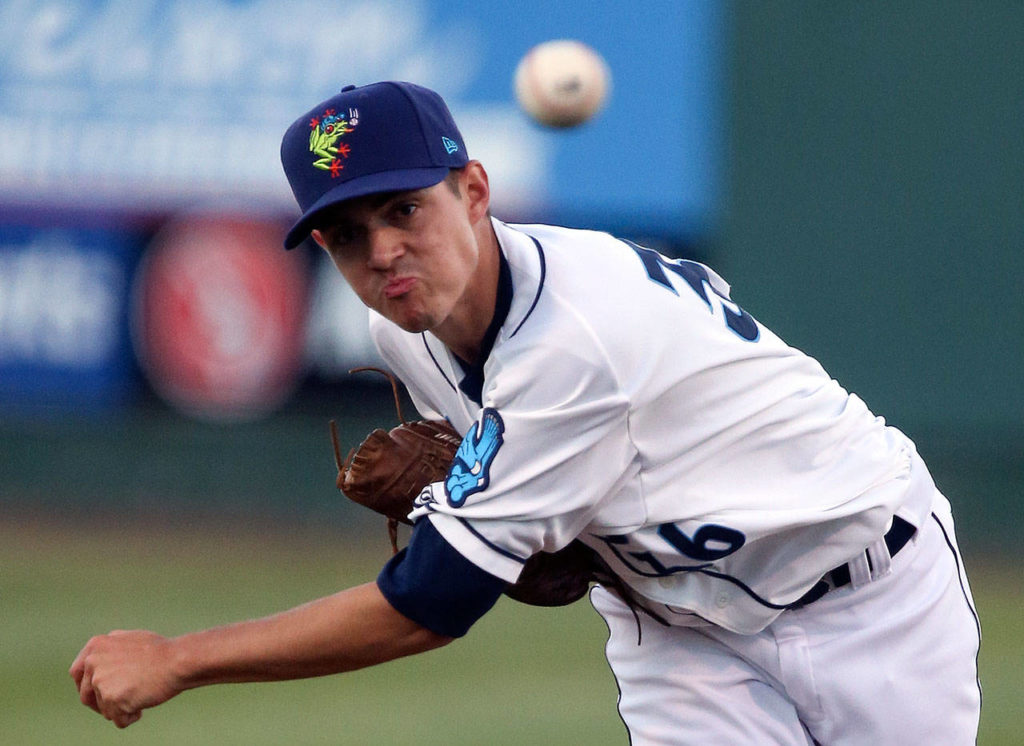SEATTLE — Last season the Everett AquaSox were playing a weekend set in the Tri-Cities —Everett’s first road trip of the year — when Troy Dixon discovered David Hesslink’s clearest path to the big leagues.
Dixon, a first-year catcher, had recently asked Hesslink, the Seattle Mariners’ 2017 34th-round pick, if he wanted to be roommates. The two were talking ball in their hotel room when a conversation shifted to an internship Hesslink completed with the Tampa Bay Rays while enrolled at the Massachusetts Institute of Technology.
“He was telling me that he created the whole defensive shifts and the outfield shifts,” Dixon recalled, “and he said it led Major League Baseball. I said, ‘You did that?’ He said, ‘Yeah. They won’t give me credit, but I did it.’ From that point on I started picking his brain about stuff.”
Many Major League Baseball operations and analytics teams desired access to Hesslink’s baseball acumen. While the 6-foot-2, 190-pound lefty starred at MIT — he became the program’s winningest pitcher — Hesslink’s work in the classroom proved most valuable to the Mariners.
“We actually had an opportunity to hire him as an intern after what was expected to be his graduation last summer,” Mariners general manager Jerry Dipoto said in a recent team podcast. “He applied for internships around the league and was widely regarded as the best intern candidate in baseball, and teams were falling over themselves trying to access Hesslink.”
Seattle ultimately drafted him, giving Hesslink a shot to make the majors as a player before contributing in a front office role.
Last year Hesslink received that opportunity in Everett. He made 15 appearances, accumulating a 5.60 ERA over 27 1/3 innings with a 1.57 strikeout-to-walk ratio.
“There were a few moments kind of spread through the Everett season,” Hesslink said, “throwing my best fastball and watching it get hit really far, that I kind of realized, ‘OK, maybe this isn’t super sustainable long-term.’”
Still, the decision to end his childhood dream wasn’t easy. But when Everett’s season ended and Hesslink knew a Seattle front office spot awaited, the new impact he could make proved too enticing to pass up.
“When I left Everett,” Hesslink said, “one of the things that sort of made me feel better about the decision is that I knew that by coming here I was going to have an opportunity to help all of the teammates I had just left.”
So Hesslink transitioned from field to front office, joining the Mariners as a 23-year-old baseball operations assistant, working in analytics with a group Dipoto said the team often bills the “Marinerds.”
The feat is quite impressive, given Hesslink had no clue what he wanted to study entering MIT. He selected mechanical engineering after being forced to choose a major, but a homework assignment his sophomore year opened his eyes to a different type of baseball career — one in which he could use his mind to help create a winning club.
Learning how to code for the first time, his assignment was to simulate the results of an at-bat using basic computer code. That led to a project where Hesslink developed a baseball simulation that accurately predicted run totals from previous MLB seasons. The algorithm accounted for numerous baseball metrics.
Afterward, Hesslink’s instructor invited him to work on a project partnering with the Houston Astros where Hesslink developed a pitch-clustering algorithm tracking velocity and vertical and horizontal movement for every pitch style while producing a 3-D map of each pitcher.
“That made me think, ‘OK, I might like doing this, let me see what it is like doing this full time,’” Hesslink said. “After I did my full internship in Tampa I thought, ‘I just had a full-time job at a baseball stadium every day, and I’m not bored of it. I think this is something I want to pursue full time.’”
And in less than a year, Hesslink already has impacted the Mariners.
He described his role as “amorphous” by design. He’s conducted amateur scouting, advanced scouting on major league clubs, worked with player development staff, minor league coaches and has completed various projects.
His favorite project, worked on during spring training, was crafting an automated process that put together holistic minor league game reports for coaching staffs to digest. The reports include pitching velocity trends and how each player did based on available metrics.
“It puts information together into an easily-parsable form that we check every morning to see how our different minor league prospects are doing,” Hesslink said.
Hesslink also played an integral role in what may turn out to be a season-altering trade for the Mariners.
Hesslink and Mariners intern and Shorecrest High graduate Skylar Shibayama proposed the idea of Seattle’s trade for Denard Span and Alex Colome last May.
“They spent night and day for about three days talking it through amongst themselves, what the best ideas were,” Dipoto said of Seattle’s baseball operations and analytics staff. “We sat in a thinktank room and had them present their ideas.
“(Hesslink) has done a marvelous job,” Dipoto said. “… Being able to access two players who can impact us over a long season like Denard Span and Alex Colome, at this stage in May, was unexpected and fortuitous.”
While Hesslink has utilized in his front office role what he gained studying at MIT, his year with the AquaSox was a tremendous benefit.
The three months last summer offered Hesslink an understanding of the minor league rigors players endure, which allows him to better connect and offer meaningful feedback.
Even still Hesslink routinely talks to Dixon, who is in his second year playing for Everett and caught Hesslink last season.
“Now instead of taking my turn out pitching,” Hesslink said, “I have access to some information here, and I sort of have a different perspective to bring to the conversation when I catch up with those guys.”
“It’s good having a guy like Dave who knows how the grind is,” Dixon said. “He can go up there and say, ‘Hey, we should do things this way, we should do things that way.’ We talk all the time. I call him for advice, talk to him about how to approach certain things and how to handle it professionally.”
While Hesslink’s impact on the AquaSox is no longer visual, there’s no doubt he’s helping Everett and has been a huge get for the entire Mariners organization.
Talk to us
> Give us your news tips.
> Send us a letter to the editor.
> More Herald contact information.


























